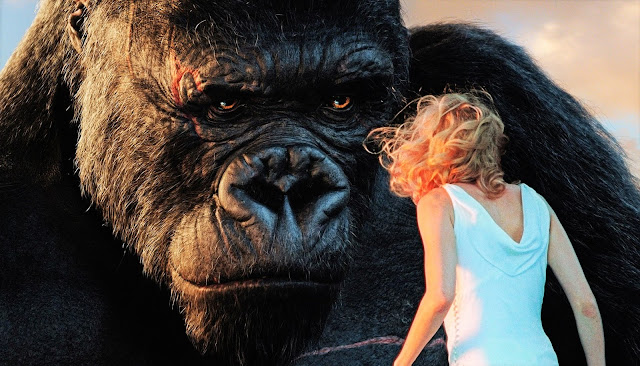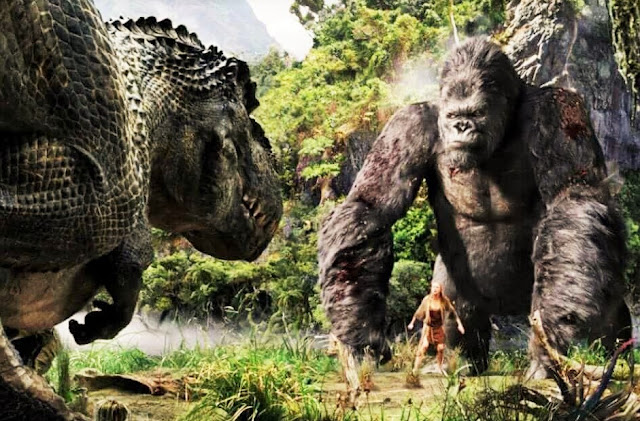King Kong: The Giant Ape
 |
| King Kong: The Giant Ape |
Dear movie monster who hits the
screen again in "Kong: Skull Island",
was originally thought to be a real gorilla - a real Komodo was battling the
dragon. Cinema's Favorite Superstar zed Ape Marking its eighth return to the
big screen in Kong: School Island, The Hollywood Reporter decides to consult
King expert, author and film historian Ray Morton for his origin. Done it was
discovered that this was a fascinating journey to the 1927 Blockbuster which
started it.
King Kong
was invented by a boy named Marian C. Cooper. He was born in Jacksonville, FL, and
became a globetrotting adventurer, in fact a color boy. He was a war hero. He
was shot twice in World War and Polish-Russo War. He escaped from a prisoner's
war camp. He had a wonderful history.
Then he returned after the war
and became a reporter for a while. And then he lastly became an explorer. He
joined an explorer team and went for all kinds of foreign places around the
world. And he and his companion, a boy named Ernest Schoedsack, started making
documentary films of these trips. So we joined the film in this way. And then
he was going into aviation when commercial aviation was in his childhood.
During one of the campaigns, he
and his partner called them "natural drama". They were like
documentaries. They will film and film real people and real animals in foreign
locations. But then he made a fictional plot. They will edit the documentary
footage to create a narrative movie based on the actual footage. They made some
money and this case became very famous.
On one of his campaigns, he saw a
Baboons family and she got an interest in her apes and then he later thought
that he wants to make a story - a natural drama about an app. A friend of her,
a searcher named Douglas Burden, went to Komodo. He was one of the first people
to visit the Indonesian island of Komodo, where he had a Komodo dragon.
Cooper suddenly got this idea. He
said that he wants to make a natural drama about an app that fights with the Komodo
dragon. He thought that would be really exciting. So that was his initial
concept. And he decided to make it a gorilla because he thought the Gorilla had
more personality than Babul. At that time the gorilla was not very well known.
They were almost a bit like mythological creatures still. The first western man
saw a gorilla late in the beginning of the 20th century or perhaps late in the 19th
century so people just did not know so much about them. This is important,
because Cooper knew that he could make them whatever he wanted.
His friend Douglas Burden had
captured Komodo dragon and brought it back to New York and kept it in the
Central Park Zoo or perhaps it was the Bronx Zoo. It was on demo for a while
and then it passed away. Cooper liked that part so the conclusion he had
concluded was a story about an expedition that went to an island on which a
gorilla and the Komodo dragon lived. (There is no gorilla on Komodo but it has
not troubled him.) And Gorilla will fight and fight against the Komodo dragon.
She will be brought back to New York City. Put in a zoo. And then it will
survive and in the end it will cause a lot of destruction before killing. He
was the natural drama he wanted to do.
 |
| King Kong: The Giant Ape |
She wanted to kidnap Gorila from
a campaign at any time and then kidnapped a woman. He was again like the myth
of the gorilla - was he like to steal women and escape with them in the forest.
So he thought it would be a good thing too.
At that time, the Enggie was a
big hit. It was originally this exploitation film, which was promoted as a
documentary - but it was not. It was a boy in an app suit of rape with a woman
in the 1930's. Bastity was its appeal. This is a very notorious film. It earned
a lot of money because it was originally an app for having sex with a woman.
Apart from this, it is very racist. It is believed that it is in Africa, so
they hired a lot of African-Americans to portray African people and then do it
in very conservative ways. As far as I know, you cannot see that movie anymore.
I'm never able to track a copy of it.
There are a lot of people who say
that there was a great impact on Kisang that Cooper was inspired by somehow. I
do not think this is true. He read stories of horror, monstrous gorilla in his
youth. I think it's a big influence on Kong. I think Bowden's campaign of Komodo
was an influence, as well as the natural drama he and Shodak made, because
Cooper was the person's idea about protectionist in the 19th century. That is,
you go out and shoot the animals and fill them up and put them in the museum
because you are worried about animals. That was the kind of thing he was about.
So Cooper went in search of
financing - but it was right when the Great Depression was killed and no one
was funding its campaign. Because the original idea was that he really wanted
to go to Africa, used to catch a gorilla and take it to Komodo so that he could
make a film in this natural environment. Nobody wanted to fund it. So the idea
went on the shelf.
In many different situations,
Cooper RKO Pictures Head David O. Selznik's assistant became assistant in the
1930s One part of their job was to see the projects and tell Selznik whether
they should or should not do them. One of the schemes was a film called manufacture.
Willis O'Brien was the person who
led the stop-motion animation as feature-film technology. He worked on a film
entitled The Lost World in the 1920's. It was for First National, which later
became part of Warner Bros. It is basically about those searchers who go to the
South American plateau and search for dinosaurs. They bring them back to London
A dinosaur runs away and causes destruction. It was based on Arthur Conan
Doyle's story.
The film was a big hit in the
mid-1920s. And O'Brien was hired with the director along with the director.
This deal was in RKO. They were going to use stop-motion animation and it was
originally a remake / sequel of The Lost World. Explorer will find dinosaurs
and they will interact with them and bring them back to society - that kind of
thing.
Cooper saw the project and did
not think it was dramatically very interesting. But he loved O'Brien's
technique. They started thinking that stop-motion could be a way to spend a lot
of money all over the world and make their own gorilla movie without traveling.
This can be done a lot in RKO. He could do it at the feet of the sound. And
O'Brien can animate the app.
Cooper's original idea was that
the app was going to be 12 feet long in his story - because people thought the
Gorilla was 12 feet long. He was not trying to make it big. He thought this is
how big a gorilla is. But then he saw dinosaur model tests which O'Brien made
for the construction. It will be better than a Komodo dragon."
And that's where the hug became
huge. Because before that there is nothing in the record, to suggest that he
wanted to make a huge app. He could not resist fighting with dinosaurs. So King Kong grew up Cooper had a showman in the heart. He used to fake,
but did not mimic his advantage. He was one of the first people behind
Technicolor. He loved cinemascope. He was the son behind Cinerama. So he used
to love anything that can separate movies - and it was different from the stage
and was different from the novels.
The thing about King Kong is the most elaborate and I
still think that the best stop-motion animation movie ever so far is. Since the
original King Kong budget was the budget of two e-pictures in those days - two
big budget facilities were put together. By that time, about $ 500,000 was
spent - or at that times a fortune for a movie, $ 10 million in today's dollar.
Almost every other stop-motion animation movie you can think of is very
entertaining. But they are a little budget and dear. Kong never was.
Live-action stuff was shot in
RKO-Pathé, which is now a Culver City studio in Culver City Studios. King
Kong's wall was finally reproduced in the form of Gone with the Wind for
Atlanta and it was burned. So when you see Atlanta falling in the Gone with the
Wind, it's actually falling on the wall of Kang. Wall 1927 Cecil B. DeMille was
left out of the Kings of Kings. All the small works, real Kong stuff, was done
at stages in RKO, which is now Paramount Studios in Hollywood.
Cooper liked a world title for
his natural plays. A grass was called. One was called Chang. Another is called
Rango. He had affection for small, two-point, and bullet-point names for his
films. The "Kong" part is actually David O. Was a Selznik. When it
was being written, there were four or five different titles: the first title
was Kong. Then its name was changed. Then its name was changed to eighth
Wonder. When he shot it, it became a Kong again. And then David O. Selznick
thought that a supernatural title would be good - and they should make them
look more brilliant. Therefore, David Selznik added "King" just
before the film was released.
Cooper told some people stories
that he got an idea for the Empire State Building because he was in Manhattan
City and saw an airplane around the Woolworth Building. It's not really true.
Cooper told many stories after the fact played well. But what really happened
when they decided to combine the monsters, they came with this idea. Cooper
thought that he want him to run around New York. But now that's huge, we have
to do something amazing." The idea was that he would climb the Chrysler
Building because the Empire State Building was not opened yet.
There was no airplane at the
original end. Kong climbed to the top
of the building and was hit by lightning and this is what he killed. But then
the Empire State Building was opened because they were writing the script. And
Cooper always wanted everything bigger and better. So what's better than the
Chrysler Building? Empire State Building! What is better than electricity? Fighter
plane!
And it is like that. All these
ideas were pulled from different places and moved in this crazy movie which
does not really make sense - except that we love it. We have to. Ray Morton is
the author of King Kong: Peter
Jackson from Fay Wray and the close Encounter of the Third Kind: The Making of
Steven Spielberg's classic film.


No comments:
Post a Comment